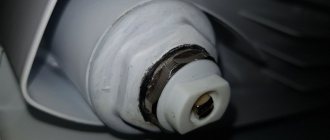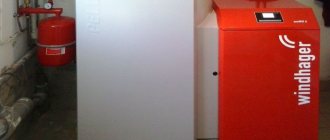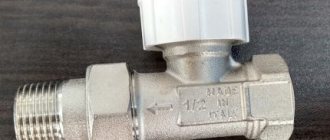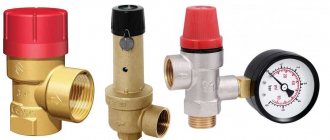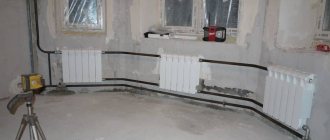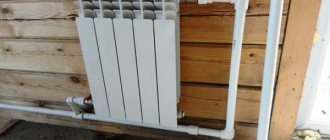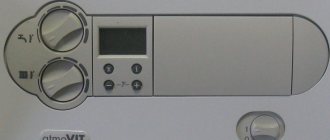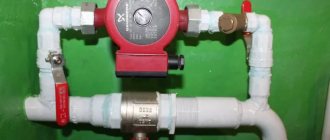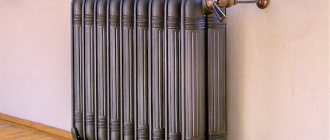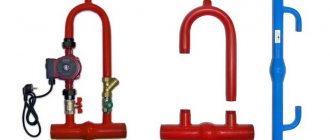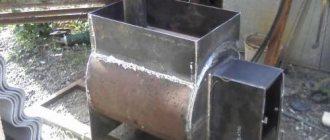Purpose and principle of operation of mud collectors
A mud trap with a filter cleans the water from particles of debris and rust, and promotes the proper operation of the equipment.
If there is debris, scale and rust in heating equipment, foreign fractions accumulate at the junction points. This leads to a decrease in the diameter of the cavities and adversely affects the operation of heat exchangers, circulation pumps, and other structures in the equipment.
When removing blockages, mud collectors for heating systems are used. They remove solid particles such as rust and scale, as well as suspended fractions that harm heating equipment.
The mechanism of operation of the dirt trap is quite simple. After water enters the pipe, the working fluid is transported into the device body. Inside it, suspended particles fall to the bottom in the form of sediment.
The mud trap is installed inside the outlet pipes. After filtration, the purified working fluid returns to the system. To clean the device from foreign fractions, the glass with sediment is removed, cleaned and put back.
Classification of mud worms
The principle of operation is to pass the coolant through a special mesh or magnetic filter, sifting out dirt fractions and depositing them at the bottom of the glass. The main condition for proper operation is the installation of the sump in the direction of the coolant flow.
Dirt filter, partially coated with primer.
Classification of mud collectors for heating systems is made according to several criteria. Depending on the degree of cleaning, fine and coarse cleaning devices are distinguished. Mounting options: threaded, flanged and welded. By service method:
- self-flushing - sediment from the sump and from the surface of the mesh is washed away by a stream of water when the tap on the mud pan is opened;
- rinsing - the glass is washed without dismantling the filter, but manually;
- non-flushing - for cleaning it is necessary to dismantle and disassemble the unit.
Wash filter for mechanical water purification.
Types of filters
Types of filters that are installed in the heating system
Classification of mud collectors for coolants is carried out according to 3 criteria:
- type of filtration of foreign fractions;
- type of service;
- installation method.
By type of particle separation
In a mesh filter for heating and heating private houses, dirt is captured by the mesh and remains in the accumulation zone. To clean the structure, the bottom of the glass is turned away and all technical debris is removed.
A heating filter with a magnetic cleaning mechanism helps eliminate metal particles. They do not reduce the fluid flow rate, which is important when operating powerful pumps.
By type of service
Internal structure of a flush-type sump tank.
Depending on the classification by type of service, filters are divided into 3 types:
- Self-cleaning. Sediment from the glass and the top of the mesh is removed with water.
- Non-flushing. When cleaning them, the coolant unit requires complete dismantling.
- Flushing. The glass requires manual cleaning.
By installation type
Depending on the installation features, mud filters for heating systems are divided into 3 types.
Mud collectors with a coupling type of connection - couplings with internal threads are located on both sides of the device. The body of the device has hexagons for inserting an adjustable, open-end and gas wrench.
Filters with a flange connection include an additional bolted sealing ring.
Devices with a polypropylene pipe circuit are used for small diameter pipes.
The water in the system will be crystal clear! Features of heating filters
Filters for the heating system ensure the quality of the coolant inside the circuit .
This prevents the formation of rust on steel structural elements, which extends its service life.
They are divided into coarse filters, fine filters and magnetic devices.
What are filters for home heating systems?
Such devices have another name - mud collectors. Externally, they represent a pipeline expansion unit with a change in the direction of fluid flow and with a special mesh.
It prevents further movement of suspended particles through the pipeline . The devices are installed in such a way that maintenance is easy.
Types of devices
Based on the degree of purification, mud collectors are classified into several types.
Rough cleaning. What is a sediment filter?
The coarse cleaning device is an angular mesh filter with a mesh of up to 300 µm-microns. The device is also equipped with a drain in which dirt accumulates. This product is designed to clean coolant from large and small fractions.
Design
Depending on the design, there are several types of coarse mud collectors:
- According to the method of connecting the device to the pipe. There are flanged, welded and threaded devices.
- By location on the structure. This is a horizontal and vertical device.
The mudguard is made of brass, steel and plastic. The first option will withstand elevated temperatures. A steel device wears out quickly. The plastic product can only withstand relatively low temperatures up to +90 degrees Celsius.
One type of coarse mud filter is a sediment filter. This is an improved design equipped with a flask. It is located at the bottom of the device. When a large amount of dirt accumulates on the mesh, it falls down under gravity. Thanks to this, such debris accumulates in the flask and does not end up in the radiators.
Photo 1. Coarse settling filter for heating systems. Contaminants from the pipes fall into a special flask.
The design is also improved with a separator. Air accumulates in it and enters the circuit. When its level reaches the limit, a valve opens on top of the device. After this, the air leaves the system, which prevents the formation of air locks.
Operating principle
There is a mesh inside the filter. This element blocks the inlet through which the coolant moves. During the passage of liquid through the mud filter, medium and large sized fractions are cut off. After this they move to the outlet. Thanks to this, relatively clean coolant flows to the radiators.
Advantages
Improved designs have the following advantages:
- Thanks to the flask, there is no need to remove the device to assess its degree of fullness. The assessment is carried out visually.
- A tap is fixed at the bottom of the device. Dirty water is drained through it.
- The filter removes air from the system, which prevents rust from occurring. This extends the life of the circuit.
Installation location and features
The installation location of the device depends on which heating system it is used for. For autonomous circuits, it is mounted at branch points, on the return before connecting to the boiler and on the bypasses.
Correct operation of the device is guaranteed by correct installation. Before installing any device, the circuit is cleaned of dirt and rust.
There are special symbols on the mud pan that indicate the movement of liquid through the pipes.
The product should only be installed in accordance with this instruction.
If the mechanism is not fixed correctly, hydraulic resistance will arise inside the structure.
Attention! The mudguard provides the circular pump with protection against debris from penetrating the blades. If you refuse to use it or install it incorrectly, the likelihood of engine and impeller failure will increase.
Fine purification for water
A fine filter is an additional filter designed to remove small fractions.
Design
There are several designs of such a device:
- with metal mesh up to 5 microns;
- with a cartridge made of fabric folded in several layers;
- with polymer porous filler;
- with mineral sorbent backfill.
Operating principle
The operating principle of such filters is as follows: water passes through a cassette and small fractions settle on its surface.
After this, the coolant moves through the pipeline without contamination. A fine mud filter cannot cope with large fractions, so it is not used as an independent filter. This is only the last stage of the heating circuit cleaning system.
Advantages
The main advantage of the filter is that it cleans the coolant from small dirt particles. This increases the service life of the circuit, since the risk of corrosion is reduced.
Where and how is it installed?
This type of mud trap is installed on horizontal pipes. It is located between the taps to block the flow of water during maintenance.
Important! antifreeze rather than water, then a fine filter cannot be installed, since such liquid does not pass through this device well.
The mud trap for fine cleaning is mounted on the pipe in the direction of water flow . There is no other way to install the filter.
Fine cleaning devices reduce the risk of an emergency.
Magnetic models of mud collectors
A magnetic filter for a heating system is a device of two magnets with polar poles, which are placed opposite each other. Such a device cleans the coolant not from contaminants, but from metals.
Photo 2. Magnetic filter for cleaning heating systems from metals. Installed on a pipe.
Design
By design, there are two types of magnetic filters:
- Removable model . This device consists of two plates that are fixed on the pipe. The advantages of the device are that it is quickly replaced and easy to install.
- Non-removable mudguard. It is a pipe made from ferromagnetic alloys.
Advantages and disadvantages
Debris from the mud trap gets into the boiler elements and interferes with normal operation.
The advantage of filters is to prevent contamination of the main components in the heating equipment. The presence of a mud trap in the system increases the service life of the coolant. In addition, among the advantages of the device are:
- fuel economy;
- reducing the cost of reagents for water purification;
- protection of convective elements of boilers.
The disadvantage of the mechanical principle of water purification is manifested in the rapid clogging of mesh filters with a high level of contamination of the working fluid. To solve the problem, a complex filtration technique is used. It consists of using magnetic mud scrapers to remove scale and rust, as well as a device with a mesh to remove suspended particles.
Dirt filters for a heating system in a private home
Each heating system contains many elements and components that perform a specific purpose. For the efficient operation of the circuit and the serviceability of the devices, the cleanliness of the coolant is very important. To clean it, various filters and mud collectors are installed for heating systems. There are several types of filters, each of which performs specific functions. An equally important heating equipment is the expansion tank. It is necessary to choose its volume correctly, because the safe operation of the system depends on it.
Purpose, pros and cons of a mud filter
The mud filter for water is designed to clean and filter the coolant. If untreated water is used as a heat carrier, then it contains various impurities and salts that contribute to corrosion of the metal elements of the heating network. Salts also settle in the form of plaque on the internal walls of pipelines, causing a decrease in the lumen of the pipes and preventing the normal circulation of the coolant.
To clean the coolant from various debris and particles, mud collectors are installed in which small impurities settle and are then removed without dismantling or depressurizing the system.
The main advantages of using mud collectors:
- Filters protect circuits from becoming overgrown with dirt and deposits. This increases the service life of pipelines, heating devices and heating equipment.
- Due to the purification of the coolant, there is no need to change it frequently and use various expensive additives.
- If the circuit through which hard water circulates has many turns, then installing several filters completely solves the problem of pipeline clogging.
- An additional benefit is the preservation of the efficiency of the heating system due to the absence of deposits and debris. The efficiency of a “clean” system reaches 40%. This includes saving on electricity, because it is easier for the pump to pump coolant, and reducing fuel costs for the boiler.
- Ease of cleaning the circuit and reducing the likelihood of leaks due to corrosion are also important advantages of installing filters. The entire structure and devices will last much longer, and network maintenance costs will be reduced.
The only downside to using mud traps is the additional cost of purchasing them, but these minor costs are more than offset by the numerous benefits. To choose a suitable filter, you need to understand their types.
Types of mud collectors in the heating system
The classification of filtration devices is carried out taking into account their structure and scope of use. There are 4 types of mud collectors:
- oblique brass;
- cast iron magnetic;
- flange magnetic;
- subscriber's
Oblique brass
The oblique brass filter is installed using threads.
These filters are equipped with a 0.5-2 inch diameter male threaded connection. These parameters are used for installation in autonomous heating systems.
The body of the mud collector is made of brass. At both ends of the device there are threaded couplings intended for mounting the device. There is a sealing gasket between the body and the plug. The direction of flow of the working fluid is displayed on the filter itself.
The device is installed in front of the circulation pump. To clean the glass, you need to turn off the coolant supply taps and place a container into which the waste will flow. The mesh is cleaned using a polymer brush and washed with a stream of warm water.
Cast iron magnetic
The difference between these filters and oblique brass mud filters lies in the material from which they are made. The parts in these devices are made of cast iron. The filter parts are made of multilayer mesh.
Flanged with magnets
Instead of a screw plug, these filters have a thin flange plug with a drain hole. In this case, you can regularly drain debris from the coolant and wash the sump tank without removing the plug.
Subscription
These mud collectors are used for installation in areas connecting private houses to heating mains. Such filters have high performance characteristics.
Subscriber
Cast iron magnetic
Flange magnetic
Heating filter for gas boiler return
Purpose of the filter for the return of a gas boiler
Water contains a certain amount of oxygen, which provokes oxidative processes. When liquid moves, abrasive particles create scratches that accelerate corrosion of the gas boiler. Rust, sand, silt and other mechanical particles accumulate in the lower parts and corners. Such blockages reduce the performance of the heating system and increase energy consumption. A typical manifestation is a decrease in the temperature of individual battery sections. To eliminate such malfunctions, labor-intensive disassembly and washing is required.
Even more dangerous are similar processes in heat exchangers. Narrow passages in household appliances increase the likelihood of accidents. Overheating of thin walls can damage the product beyond repair. New parts have to be installed, which creates additional difficulties in winter.
The next problem is caused by a clogged air vent. As a result, the pressure in the system drops until the boiler automatically turns off. Some solid impurities can damage the circulation pump.
Separately, heaters of the electrode category should be considered. These products perform their functions economically only under certain coolant parameters. Changes in electrolytic properties in the presence of contamination reduce performance.
A mechanical filter for the return of a gas boiler will eliminate the problems listed above. However, it is powerless in the presence of hardness salts in the coolant. Such impurities are normally dissolved. They will not be held back by a mesh with the smallest cells, a carbon cartridge, or long-term settling. Therefore, for comprehensive protection, you will need to install a filter in front of the gas boiler, as well as other specialized devices.
How does a heating system return filter remove mechanical impurities?
Industrial boiler houses and large real estate properties are equipped with gravity-type mud collectors. To connect to the pipeline, a wide flange connection with a sealing gasket is used. During installation, the housing is installed vertically. The septum is fixed along the central axis, leaving ducts in the lower and upper parts. Such a simple addition changes the direction of liquid flow and cuts off mechanical impurities. They accumulate at the bottom. Contaminants are regularly removed during preventative maintenance.
In household systems, a filter is used on heating systems with a removable mesh. The diameter of the main part is approximately equal to the dimensions of standard pipes. For connection, couplings with external (internal) threads are used. An oblique outlet with a built-in separator is directed downward in the direction of the water flow. The correct position is indicated by an arrow on the body.
“Self-cleaning” modifications are more convenient for users. Such filters for heating the return of a wall-mounted boiler are equipped with a valve in the bottom part. Through it, contaminants are washed into the drainage. Completely autonomous products are complemented by a solenoid valve and a control unit. The timer is set to the optimal time interval corresponding to the actual concentration of impurities and operating mode.
To retain steel particles, filters with permanent ring magnets are installed. To increase efficiency, in some modern models the operating elements are placed in the central part. This solution increases the resistance to water flow, so it is necessary to control the resulting outlet pressure level. It should be remembered that the automation of a gas boiler can turn off the equipment if the pressure is insufficient.
In heating systems, separating elements with free flows of 350-1000 microns are used. Finer cleaning is used to remove the smallest impurities 5-200 microns. Such operations are performed using bulk fillers and granular backfills.
A typical solution for an apartment or private house is a brass mud pan with coupling threaded connections. The end of the oblique cylinder is closed with a plug with a shaped protrusion for a wrench. The limit parameters of standard products in this category are presented below:
- Nominal/pressure pressure in the pipeline, bar: 20/30-16/24;
- Mesh cell sizes, microns: 500-1000;
- Number of cells per square cm, pcs: 156-59;
- Thread, inches: ½-2;
- Conditional bore, mm: 15-50;
- Height/length, mm: 40/50-88/126;
- Weight, g: 130-1150;
- Maximum coolant temperature: from +120°C to +155°C;
- Total area of the working element, square cm: 18-110;
- Throughput of the device when working with a cleaned mesh, m cubic. per hour: 3-29;
- Estimated service life, years: 25-30.
Installation rules
Subscriber filter in the heating system
All filters on the transparent panel have an arrow in the direction of the working fluid. Installation of mud traps for heating occurs subject to strict adherence to this instruction. The best options for the location of these devices are:
- metering devices;
- circulation pumps;
- near the regulatory structures of the system.
When installed horizontally, the spout of the device is placed at the bottom, and when installed vertically, on the side. Otherwise, extraneous fractions will not be removed from the system. It is recommended to install check valves and shut-off valves in front of the dirt trap, and pressure reducing valves behind them to control pressure indicators.
Functions of mud collectors
When operating heating, water supply and other similar lines, one of the most pressing problems is the clogging of various areas with insoluble impurities of organic and inorganic origin - in other words, dirt. In open systems in which water is drawn from an external source, sand, clay particles, silt, etc. most often act as pollutants. In closed pollution systems, rust flakes, scale, separated scale fragments, and mineral deposits also occur. They all have one common property: most of these particles are heavier than the water or coolant circulating in the system.
A section of a pipe with pronounced silting. Accumulating in those places where the fluid flow slows down or changes direction, dirt over time significantly reduces the performance of the system - permeability, heat transfer, etc.; in some cases, serious blockages can lead to system failure. There is a need for mechanical or chemical cleaning (rinsing) of clogged elements. In order to reduce the concentration of dirt particles in the liquid, reduce the rate of blockage formation, and thereby reduce the frequency of complex and expensive cleaning or repair procedures, various filters are used. In particular - the so-called coarse filters, which include mud filters. Sometimes they are called mud collectors, as well as clarifiers: with an effectively functioning mud collector, at the outlet of it, the pumped liquid is even visually much cleaner and lighter than at the inlet.
Maintenance of mud traps in the heating system
Once a year, the coarse filter must be unscrewed and cleaned.
Filters for a heating boiler must be cleaned 2-3 times a year. The frequency of the procedure depends on a number of specific factors, the main ones being:
- equipment dimensions;
- number of units and control valves;
- degree of pre-cleaning.
Often, you can clean a household dirt trap yourself. To do this, you need to close the valves, unscrew the glass, remove it and thoroughly clean the filter itself.
Installing a mud pan is one of the mandatory heating elements with a large number of components and control valves. The filter increases the service life and efficiency of the system.
Varieties
To reduce the risk of boiler breakdown, increase the accuracy of measuring instruments and ensure long service life of the equipment , it is important to understand the main types of devices and choose the right one.
Polyphosphate
Polyphosphate units are considered a budget option for pre-purification and softening of water entering the boiler.
The operating principle of such a device is to pass liquid through a flask filled with special crystals. They ensure the formation of a protective film on the inner walls of the boiler and also slow down the formation of scale.
Photo 1. Polyphosphate filter for a gas boiler, filled with special crystals. They slow down scale formation.
The devices have a simple design:
- drain;
- flask;
- filler;
- lid.
The liquid enters the flask with filler through the lid, where it is passed through polyphosphate crystals. Next, it goes through the drain into the gas boiler tank.
Any device of this type requires periodic replacement of the filler - sodium salt crystals. As a matter of fact, this is the only difficulty in servicing them. The average lifespan of such a treatment plant is up to one and a half years.
Electromagnetic or magnetic for softening hard water
Electromagnetic devices are expensive, but the price is completely justified: the installation lasts a long time and allows you to obtain perfectly clean water at the output.
The principle of operation is that when the liquid passes through the flask, the salts in it disintegrate. Thus, scale will not settle on the walls of the boiler. Instead, the filter itself will be clogged with tiny salt particles, which is periodically washed.
Photo 2. Three magnetic filters for a heating system boiler; the scale in them breaks down into tiny particles.
Another characteristic is that under the influence of electromagnetic radiation, not only does the scale disintegrate into small particles, but also a thin film is formed that covers the boiler heat exchanger. Thanks to this, it remains protected and does not corrode for a long time.
